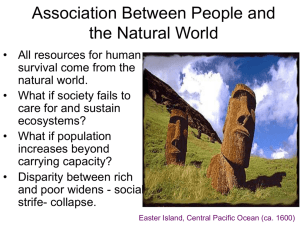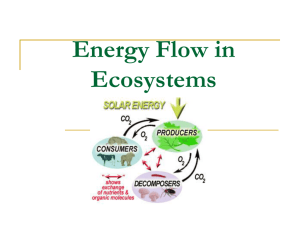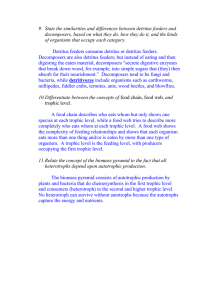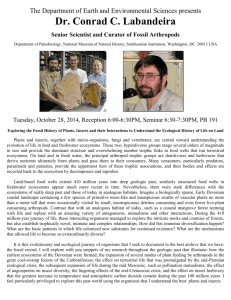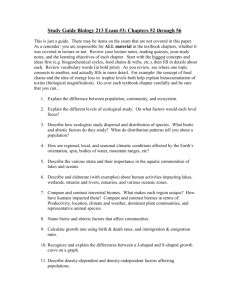Ch 2.Ecosystems
advertisement
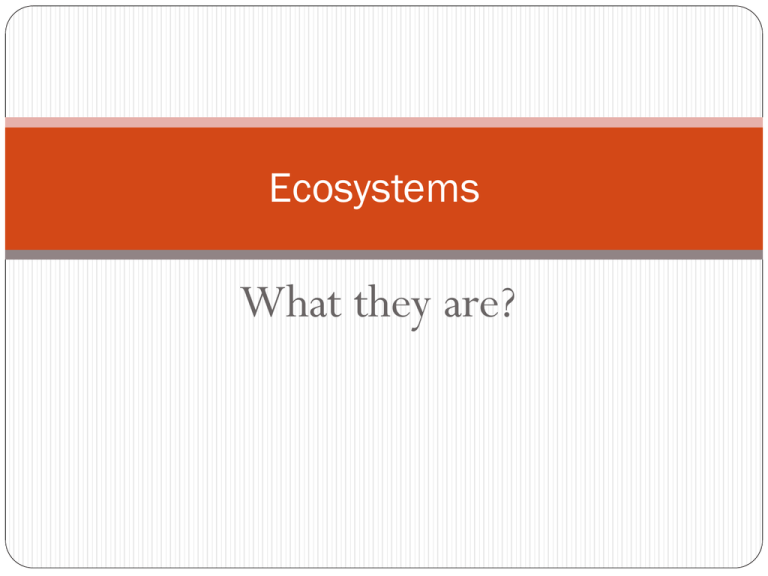
Ecosystems What they are? Plum Island The State of the Nation’s Ecosystems: Measuring the lands, waters, and living resources of the United States. Six major types of ecosystems: Coasts and oceans Farmlands Forests Fresh waters Grasslands and shrublands Urban and suburban areas Indicators System dimensions Ecosystem extent Fragmentation and landscape pattern Chemical conditions Nutrients, Carbon and oxygen Contaminants Physical Biological components Plants and animals Communities Ecological productivity Human uses Food, fiber and water Recreation and other services 1) What are Ecosystems? Ecosystems are the biotic and abiotic factors in a specified area that interact with one another. Understanding the interaction of the biotic and abiotic factors in an ecosystem can help us to see why particular human activities may be a problem for human survival. Example: The loss of ozone in the stratosphere increases the quantity of UV radiation on the surface of the planet. In the same way that humans experience sunburn from too much sun exposure, so do plants. Excessive UV may damage or destroy plant protein and DNA, killing the plant. Important ecological terms Biotic communities: All the populations of different plants, animals and microbes occupying a given area. Abiotic factors: All the factors of the physical environment: moisture, temperature, light, wind, pH, type of soil, salinity, etc. Important ecological terms Ecology: Study of ecosystems and the interactions that occur among organisms and between organisms and their environment Ecologist: The investigators who conduct ecological studies Important ecological terms Species: All the members of a specific kind of plant, animal or microbe; a kind given by similarity of appearance or capacity for interbreeding and producing fertile offspring Populations: All the members of a particular species occupying a given area. Associations: A plant community with a definite composition, uniform habitat characteristics, and uniform plant growth. Important ecological terms Ecotone: transitional region that shares many of the species and characteristics of two ecosystems. It also includes unique conditions Fig. An ecotone may create a unique habitat with specialized species not found in either of the ecosystems bordering it. Important ecological terms Landscapes: group of interacting ecosystems in a particular area. A barrier island, a saltwater bay, constitute a landscape Fig. Ecosystems are not isolated from one another. One ecosystem blends into the next through a transitional region, an ecotone, which contains many species common to the two adjacent systems. Important ecological terms Biomes: grouping of all the ecosystems of a similar type. I.e. tropical rain forests, grasslands, deserts, etc. Biosphere: All the species on Earth, along with all the environments, make up one vast ecosystem, the Biosphere. 2) The structure of Ecosystems Feeding relationships Trophic structure Trophic structure Producers Consumers Detritus feeders and decomposers Trophic structure 1) Producers: capture energy from the Sun or chemical reactions to convert carbon dioxide, an inorganic molecule into organic matter. •What is the difference between organic and inorganic molecules? • Producers are also known as autotrophs. What is an autotroph? Trophic structure 2) Consumers: - - - Primary consumers: feed directly on producers (herbivores) Secondary consumers: feed on primary consumers (carnivores) Omnivores: feed on both plants and animals Consumers are also known as heterotrophs. What is an heterotroph? The Structure of Ecosystems Feeding relationships among consumers Predator/prey relationships: any relationship in which one organism feeds on another. Parasites: plants or animals that become intimately associated with their “prey” and feed on it over an extended period of time without killing it. The organism that is fed upon is called host. Pathogens: bacteria and viruses that cause disease Trophic structure 3) Detritus feeders and decomposers: Organisms that feed on death plants or animals, feaces, etc. Primary detritus feeders: organisms that feed directly on detritus Decomposers: secrete digestive enzymes that break down dead matter. I.e. bacteria and fungi. Secondary detritus feeders: feed on primary detritus feeders. I.e. protozoans, mites, insects, and worms. Are detritus feeders autotrophs or heterotrophs? Trophic categories AUTOTROPHS HETEROTROPHS PRODUCERS CONSUMERS DETRITUS FEEDERS AND DECOMPOSERS Photosynthetic green plants Primary consumers (herbivores) Decomposers (fungi and bacteria) Photosynthetic bacteria Omnivores Primary detritus feeders Chemiosynthetic bacteria Secondary consumers (carnivores) Secondary and higher orders of detritus feeders Higher orders of consumers (carnivores) Parasites: plants or animals 2) The structure of Ecosystems Feeding relationships Trophic relationships Trophic relationships a. Food chains: feeding pathways Food chains are a description of who eats whom. Predator-prey and host-parasite describe specific feeding relationships. b. Food webs: complexes of feeding relationships. c. Trophic Levels or Feeding Levels All producers belong to the first trophic level. All herbivores (primary consumers) are on the second trophic level. All primary carnivores (secondary consumers) are on the third trophic level. Trophic Relationships Food chain Food web 2) The structure of Ecosystems Feeding relationships Biomass and biomass pyramids Biomass and biomass pyramid All organic matter can be defined as biomass All biomass can be arranged into a feeding relationship with the producers on the first trophic level. Biomass and biomass pyramid On average, 10% of the energy from one trophic level moves to the next trophic level. 2) The structure of Ecosystems Non-feeding relationships Non feeding relationships 1) Mutually Supportive Relationships: mutualism. 2) Competitive Relationships How are competitive relationships reduced? Habitat: place Niche: role What happens when competition is not reduced? Competitive exclusion principle ABIOTIC FACTORS Conditions: abiotic factors that vary in space and time, but are not used up or made unavailable to other species. i. e. temperature, wind, pH, salinity, fire Resources: factors (biotic or abiotic) that are consumed by organisms. i.e. water, chemical nutrients, light, oxygen 2) The Structure of Ecosystems Limiting Factors Factors that limit growth, reproduction or even survival of a population. Biotic or abiotic Basic items include temperature, light, oxygen, carbon dioxide, and precipitation. Only one limiting factor need be out of its optimum range to cause stress for an organism. Optimum, zones of stress and limits of tolerance Optimum: level at which an organisms do best. Range of tolerance: the entire span that allows any growth at all. Limits of tolerance: points at the high and low ends of the range of tolerance Zones of stress: between the optimal range and the high or low limit of tolerance Range of tolerance Limiting factors Law of Limiting Factors - Quantities of any single factor above or below optimum levels necessary for organism growth, reproduction, or survival will limit growth, reproduction, or survival. Synergistic effects (synergism): two or more factors interacting in a way that causes an effect much greater than one would anticipate from the effects of each of the two acting separately. 3) Global biomes The Role of Climate The role of climate Climate: describes the average temperature and precipitation of a given region Weather the daily variations in temperature and precipitation Vary widely in different parts of the world. A given climate supports only those species that find the temperature and precipitation levels optimal or within ranges of tolerance. Temperature and precipitation combine to create the world's biomes. Activity: Describe how ecosystems change as temperature and precipitation change: b.Vary precipitation while temperature is held constant a.Vary temperature while precipitation is held constant Activity: Describe the effects of altitude and latitude 3) Global biomes Microclimate Microclimate MicroclimateSpecific sites with temperature and moisture conditions significantly different from the overall or average climate of the region in which it is located. Microclimates. Abiotic factors such as terrain, wind, and type of soil create different microclimates by influencing temperature and moisture in localized areas 4) Implications for humans The three revolutions: 1. Neolithic Revolution a. Development of agriculture b. Required permanent or long term settlements and specialized skills c. Allowed for the initial increase in human population reliable food. 2. Industrial Revolution a. Created the modern world b. Energized by fossil fuels (initially timber). resulted in the concentration of waste products d. Created even greater increase in human population size because of the specialization of the workforce and the replacement of animal/human power with fossil fuels. Environmental Revolution a. Need to create sustainable human systems b. Need to create systems in which waste products are not concentrated (pollution), and wastes are resources. 3. http://www.harmonartillustrations.com/store/murals.php http://emilyyyyyyyyyy.glogster.com/food-web-/ http://drake.marin.k12.ca.us/stuwork/rockwater/PLANKTON /Food%20Chain.htm http://cumuseum.colorado.edu/Research/Objects/sep04_liche ns.html http://www.colorado.edu/geography/courses/geog_1001_lab/ http://apesnature.homestead.com/chapter2.html http://www.exploringnature.org/db/detail.php?dbID=45&detI D=2589 http://gohealed.com/ http://pediaview.com/openpedia/Detritivore

